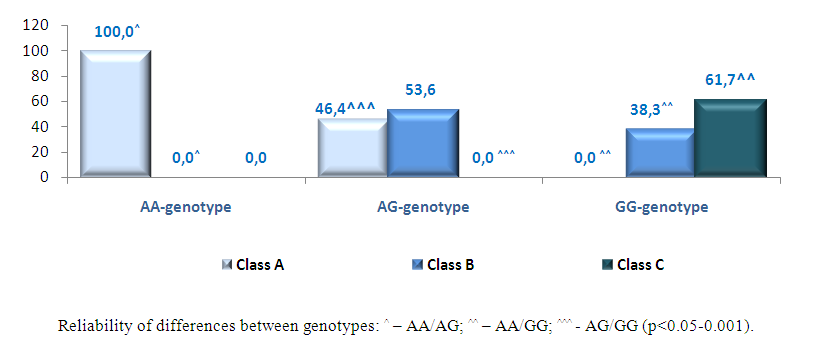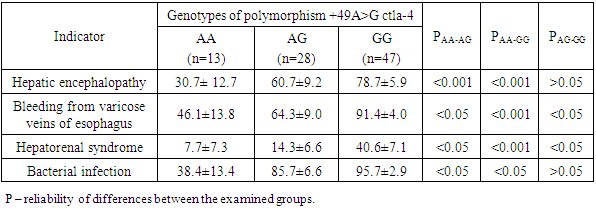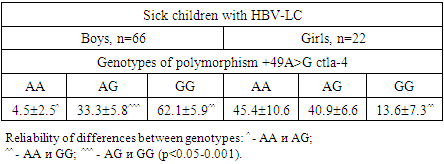-
Paper Information
- Next Paper
- Previous Paper
- Paper Submission
-
Journal Information
- About This Journal
- Editorial Board
- Current Issue
- Archive
- Author Guidelines
- Contact Us
American Journal of Medicine and Medical Sciences
p-ISSN: 2165-901X e-ISSN: 2165-9036
2023; 13(1): 13-17
doi:10.5923/j.ajmms.20231301.04
Received: Dec. 8, 2022; Accepted: Dec. 29, 2022; Published: Jan. 13, 2023

Associative Prognostic Parallels between the Polymorphism rs231775 and rs5742909 of Ctla-4 Gene and HBV-Liver Cirrhosis Progression in Children
Inoyatova Flora Ilyasovna1, Inogamova Gulnoza Zakhidjanovna2
1Russian Academy of medical Technical Science, Science Academy of Uzbekistan, Academician, Scientific Department of Hepatology, Republican Specialized Scientific Practical Center of Pediatrics of the Ministry of Health of the Republic of Uzbekistan
2Scientific Department of Hepatology of the Republican Specialized Scientific Practical Center of Pediatrics of the Ministry of Health of the Republic of Uzbekistan
Correspondence to: Inoyatova Flora Ilyasovna, Russian Academy of medical Technical Science, Science Academy of Uzbekistan, Academician, Scientific Department of Hepatology, Republican Specialized Scientific Practical Center of Pediatrics of the Ministry of Health of the Republic of Uzbekistan.
| Email: |  |
Copyright © 2023 The Author(s). Published by Scientific & Academic Publishing.
This work is licensed under the Creative Commons Attribution International License (CC BY).
http://creativecommons.org/licenses/by/4.0/

The objective. To establish the prognostic significance of ctla-4-gene polymorphisms of rs231775 (+49A>G) and rs5742909 (+318C>T) in the progression of HBV-cirrhosis of the liver (HBV-LC) in children. Methods. We examined 88 sick children with HBV-CP (according to Child-Pugh: class A – 29.5%, class B - 27.8%, class C – 42.7%), aged 6-18 years, among whom there were 75% boys and 25% girls. The duration of HBV-CP was 7.8±0.2 years. The diagnosis was established on the basis of clinical biochemical and instrumental test such as ultrasound with Dopplerography and fibroelastometry using SMI and ASQ technology. Verification was done using HBV - methods of ELISA and PCR. Prognostic criteria of the MELD/PELD scale were used. Genotyping was performed by PCR-RFLP analysis of rs231775 (+49A>G) and rs5742909 (+318C>T) polymorphisms of the ctla-4 gene. The prevalence of alleles and genotypes among cases and controls was compared according to the Hardy-Weinberg equilibrium law using the χ2 criterion. The control group consisted of 90 practically healthy children.Results. Investigation of genetic polymorphisms of rs231775 (+49A>G) and rs5742909 (+318C>T) of the ctla-4 gene in patients with HBV-CP provided the possibility to establish associative-prognostic links only with the carrier of the positional variant +49A/G, which was manifested by high expression of the gene compared to healthy donor children and indicated a genetic predisposition to the formation of liver cirrhosis in cases of HBV infection. At the same time, the carriage of the G-allele in the homozygous mutant GG position was associated with a high probability of rapid decompensation of the pathological process in liver and development of frequent complications. While the A-allele is in the AA-homozygote position was associated with a compensated progression of the disease. Determined gender differences including the high expression of the G-allele of the ctla-4 gene characteristic for boys, particularly in the homozygous mutant variation of GG, partially substantiates the phenomenon of high susceptibility and prevalence of HBV infection among boys.Conclusion. In contrast to the polymorphism of +318C>T, the existing difference in the prevalence of polymorphism +49A/G alleles of the ctla-4 gene proves the susceptibility to the formation of characteristic progression of HBV-LC in children and justifies the fact that this gene serves to be a partially active mechanism in the development and progression of the pathological process in case of HBV persistence. The GG genotype carriage in the positional variant +49A/G of the ctla-4 gene can be considered to be one of the HOST factors for the dominant susceptibility of boys to the formation of HBV-LC and, in general, for the prediction of the unfavorable progression of the disease in children.
Keywords: Liver cirrhosis, HBV infection, Ctla-4 gene, Polymorphisms +49A>G and +318C>T, Clinic, Prognosis, Children
Cite this paper: Inoyatova Flora Ilyasovna, Inogamova Gulnoza Zakhidjanovna, Associative Prognostic Parallels between the Polymorphism rs231775 and rs5742909 of Ctla-4 Gene and HBV-Liver Cirrhosis Progression in Children, American Journal of Medicine and Medical Sciences, Vol. 13 No. 1, 2023, pp. 13-17. doi: 10.5923/j.ajmms.20231301.04.
Article Outline
1. Introduction
- The problem of liver cirrhosis (LC) is caused not only by the complexity of pathogenesis, the severity of complications, insufficient effectiveness and high cost of antiviral treatment, but also by the infection of the most susceptible to chronic HBV infection groups of the population, particularly children (up to 64.7–95% of cases), the development of early disability and deaths (2.7-5.4% of all cases of childhood mortality) [1,2,3, et al.]. LC can be the final stage of the development of both progressive and latent forms of chronic HBV infection, where the development of hepatocellular carcinoma can reach up to 70-90% of cases, which significantly reduces the survival rate of sick children [4-9]. The course of the disease is mainly associated not only with viral factors, but also with the encoded genetic fund of the macro-organism. In particular, the processes of fibrogenesis are regulated by specific genes, among which we consider ctla-4 gene, which triggers such pathological processes as apoptosis, proliferation and differentiation mediated through a cascade of immunopathological reactions [10-13]. At its core, ctla-4 is an inhibitory receptor that restricts T-cell activation. Its gene modifications (-318C/T, 49G/A, 7-30A/T, and others) are associated with various degrees of ctla-4-mediated effect on T-cell activation and response to interferon therapy, as well as with an increased risk of chronic infection [14,15]. In this regard, the role of ctla-4 genetic determinants is being actively studied, which makes it possible to diagnose and predict the course of the disease, the risk of complications and unfavorable outcome with greater accuracy [16,17]. These facts emphasize the relevance of studying many aspects of the problem in order to solve such important issues as increasing the duration and improving the quality of life of the children with HBV-liver cirrhosis.
2. The Objective
- To establish the prognostic significance of polymorphisms rs231775 (+49A>G) and rs5742909 (+318C>T) of ctla-4 gene in the progression of HBV- liver cirrhosis (HBV-LC) in children.
3. Materials and Methods
- We examined 88 sick children with HBV-LC, aged 6-18 years, among whom there were 75% boys and 25% girls. According to Child-Pugh classification there were Class A 29.5%, class B 37.5%, and class C 33% of children. Prognostic criteria of the PELD (<12 years) and MELD (>12 years), scale were used [18]. The duration of the disease was 7.8 ± 0.2 years. The diagnosis was established on the basis of clinical biochemical and instrumental tests (ultrasound on the PHILIPS HD3 scanner with Dopplerography of the vessels of the liver, spleen and portal system; shift-wave elastometry (SWE, ASQ); MRI, EGDS). We also performed microbiological tests of biological fluids (blood, ascites liquid, urine, sputum, feces). Verification of HBV, HCV and HDV was carried out by ELISA methods using HUMAN kits (Germany) on a MULTISCANFC device and Real Time PCR (HBV-DNA) with hybridization-fluorescence detection on a BIO-RADiQ5 amplifier (USA) using Ampli Cens RHBV-FL kits (Russia). Genotyping was performed by PCR-RFLP analysis of rs231775 (+49A>G) and rs5742909 (+318C>T) polymorphisms of ctla-4 gene. Restriction primers for the determination of polymorphism A49G and C318T of ctla-4 genes were selected using the online programs NCBIPrimersTool and Nebcutter. PCR amplification was performed using the PCRCore kit (Isogen, Russia). Weights of restricted products were as follows: AA – healthy genotype – 162 bp/21bp; AG – heterozygous genotype – 162 bp/91bp/71bp; GG – mutant genotype – 91bp/71bp; CC – healthy genotype – 226bp/21bp; CT –heterozygous genotype – 226bp/130bp/96bp/21bp and TT – mutant the genotype is 130 bp/96 bp/21bp. The prevalence of alleles and genotypes among cases and controls were compared according to the Hardy-Weinberg equilibrium law using the χ2 criterion. The control group consisted of 90 practically healthy children. The results of clinical and laboratory tests were processed by the method of variation statistics.
4. Results and Discussion
- Genotyping of rs5742909 polymorphism (+318C>T) of ctla-4 gene in patients with HBV-LC and practically healthy children showed the absence of associative relationships, i.e. all examined children were carriers of a healthy homozygous genotype +318CC (Table 1). In contrast, the study of rs231775 polymorphism (+49A>G) revealed the presence of associations with ctla-4 gene in sick children with the prevalence of the following genotypes: homozygous AA in 14.8% of cases, heterozygous AG - 31.8% and mutant GG genotype in more than half of the cases – 53.4%. At the same time, statistical significance to healthy donors was obtained in homozygous AA- and GG-carrier variants. In general, healthy donor children had characteristic homozygous AA genotype (66.6%).
|
|
 | Figure 1. The prevalence of polymorphism genotypes +49A>G of ctla-4 gene dependent on the severity of HBV-liver cirrhosis in children, % |
|
|
5. Conclusions
- Genetic polymorphisms rs231775 (+49A>G) and rs5742909 (+318C>T) of ctla-4 gene in patients with HBV-LC were associated only with the carriers of the positional variant +49A/G, which was manifested by high expression of the gene compared to healthy donor children and indicated a genetic predisposition to the development of liver cirrhosis in cases of HBV infection. At the same time, the carriage of the G-allele homozygous mutant GG position was associated with a high probability of rapid decompensation of the pathological process in liver and the development of frequent complications. While A-allele in the AA-homozygote position was associated with a compensated progression of the disease. The established gender differences such as high expression of G-allele of ctla-4 gene characteristic for boys, especially with homozygous mutant variation of GG partially substantiates the phenomenon of high susceptibility and infection rate among boys with HBV viral infection, since the main regulatory ability of T-cell immunity is associated with the G-allele.The existing difference in the prevalence of polymorphism alleles +49A/G of ctla-4 gene and the susceptibility to the development of HBV liver cirrhosis in children justifies the fact that this gene serves to be a partially active mechanism in the development and progression of the pathological process in cases of HBV persistence. Consequently, the 49-position carriage of the mutant GG variation of ctla-4 gene can be considered to be one of the HOST factors in the prediction of unfavorable progression of HBV cirrhosis in children, which allows timely definition of risk groups at the stage of primary diagnosis and its preventive measures, respectively. Conflict of Interest: The author confirmed the absence conflict of interest and financial support to be reported.
 Abstract
Abstract Reference
Reference Full-Text PDF
Full-Text PDF Full-text HTML
Full-text HTML


